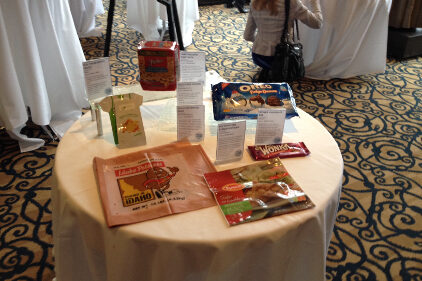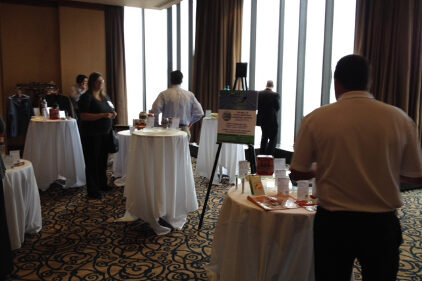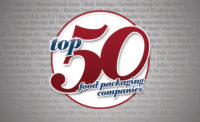Roughly 130 people gathered in Minneapolis on a cold, snowy spring day to launch the Best of Food and Beverage Packaging event on Tuesday April 29. The first day kicked off with a tour of three facilities in the area: H.B Fuller, Laser Sharp FlexPak and LasX Packaging. At the H.B Fuller Packaging Center of Excellence, we had the chance to hear from Kim Essex, Senior VP and North American Director of Food and Nutrition at Ketchum. She shared with us top food and beverage packaging trends she sees in the retail space. Essex spoke of packaging that assigns a sense of place, for instance chocolate bars from Venezuela. The packaging for these will highlight the origin and the rich culture that surrounds the product. Also, she mentioned the trend of packaging that tells a story and includes company history information, goals, origin and more to really connect with buyers. Other trends include the practical — like extending fridge life, enhancing product preservation (with tighter seals) and packaging that signals expiration like temperature regulated labels for milk and cheese.
That evening, attendees had a chance to mingle, network and check out the entries into the Best of Food and Beverage packaging awards that were on display on site. Wednesday kicked off with breakfast, and then started right away with the speaker presentations. Within presentations from General Mills to Angie’s Artisan Treats and Dine, some common themes emerged from the event.
Wynn Wiksell at General Mills was the event’s keynote speaker. He spoke to us on the topic of packaging innovation and what changes are arising today. Today’s market is revealing changes in distribution with the rise of online shopping, even for groceries. Amazon Fresh online is growing and this changes how packaging should look since consumers are no longer touching the product (online shopping makes us lose that experience). Resources are also changing as the population is growing. Resource constraints are pushing innovation in packaging by using less materials and increasing performance with cost effective films. Another emerging trend is trust in a company. Consumers want transparency and are asking, “who is making our food?” and “where is it coming from?”
Consumer wants and needs are affecting packaging innovation more than ever. In a culture of social media where we can hear customer feedback (wanted or not) via facebook, twitter, email, Linkedin and more, CPGs are bombarded with what the consumers want. And they are not just hearing these wants, they are working hard to meet those needs and wants to build better rapport with their customer base. In addition to the social media boom, we also more than ever live in a culture of getting our food and beverages just the way we want them, when we want them. We want them gluten-free, nut-free, organic, vegan and/or local. And we are getting it all thanks to a changing landscape which focuses on key areas to meet the needs of the changing consumer.
Chris Cornryn from Dine Packaging spoke about disruptive packaging, which is a new package to disrupt the current market and solve a need. It starts with finding out what that need is. Cornryn stressed the importance of getting the consumer insight right. He suggests creating ideas that endure and hit a business objective. Also, he stressed using a food-centric approach, a holistic approach and getting out there to understand and meet consumer needs. Today’s consumers are focused on a couple of things: Is this food good for me? Is it good for my culture? Is it good for the environment? Aside from the food itself, packaging should answer those questions and affirm that this product is for them.
Angie Bastian from Angie’s Artisan Treats took the stage on Wednesday to talk about how she started the now successful popcorn company in 2001. What started as a very small startup company selling popcorn in parking lots, grew to what is now a multi-million dollar company. Bastian stressed that she relied on hard work, as well as trial and error to get her to where she is today. She also stressed the importance of how packaging and marketing helped shape her success. In 2008 the brand went through what she called a “serious phase”— they adopted a new look and new design that was too dark on the shelf, causing people to miss it entirely. This led to a packaging overhaul and the new (and current) branding for the sea salt popcorn, Boomchickapop, complete with bold letters, bright colors and exciting design. Within four months, it became the number one selling SKU. The company then overhauled the entire packaging line to incorporate the new look. In 2012 Angie won Best Packaging at Natural Products East. She said that sales increased 96% year over year since the brand overhaul in 2012. The popcorn didn’t change; just the branding and packaging did, proving its importance with today’s consumers.
The event wrapped up Thursday with the Best of Food and Beverage Packaging awards ceremony. Food and Beverage Packaging and Packaging Strategies honored fourteen of North America’s most creative packaging companies, designers and brand owners as winners of the awards. There were more than 30 entries competing for most innovative packages in five categories: rigid plastic, flexible plastic, metal, glass and paperboard. The Zipz wine goblet, submitted by Selig Group, won in rigid plastic. The Wonka Chocolate Bar, submitted by Printpack won in flexible plastic. Eco Canister, submitted by Ecologic Brands, won in paperboard. Molson Canadian Cider, submitted by Spring Design Partner, won in metal and in glass, the winner was Wakaya Perfection Organic Pink Fijian Ginger Powder, submitted by Wakaya Perfection.





